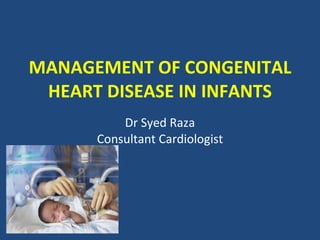Management of congenital heart disease in infants
•Als PPT, PDF herunterladen•
59 gefällt mir•20,663 views
PRESENTATION FOR NON CARDIOLOGISTS
Melden
Teilen
Melden
Teilen

Weitere ähnliche Inhalte
Was ist angesagt?
Was ist angesagt? (20)
Andere mochten auch
Classification of Congential Heart Diseases and cyanotic heart disease

Classification of Congential Heart Diseases and cyanotic heart diseaseChristian Medical College & Hospital
Andere mochten auch (20)
A good ppt on Clinical congenital heart disease for Post Graduate

A good ppt on Clinical congenital heart disease for Post Graduate
Classification of Congential Heart Diseases and cyanotic heart disease

Classification of Congential Heart Diseases and cyanotic heart disease
surgical approach of cyanotic congenital heart disease

surgical approach of cyanotic congenital heart disease
Congenital heart disease, by dr Shaymaa Fayad, El Nasr Hospital Port said

Congenital heart disease, by dr Shaymaa Fayad, El Nasr Hospital Port said
History and physical examination of congenital heart disease

History and physical examination of congenital heart disease
Ähnlich wie Management of congenital heart disease in infants
Ähnlich wie Management of congenital heart disease in infants (20)
Eisenmenger Syndrome Dr md toufiqur rahman cardiologist nicvd

Eisenmenger Syndrome Dr md toufiqur rahman cardiologist nicvd
Drs. Escobar, Pikus, and Blackwell’s CMC X-Ray Mastery Project: January Cases

Drs. Escobar, Pikus, and Blackwell’s CMC X-Ray Mastery Project: January Cases
Mehr von SMSRAZA
Mehr von SMSRAZA (20)
Kürzlich hochgeladen
Cara Menggugurkan Kandungan Dengan Cepat Selesai Dalam 24 Jam Secara Alami Bu...

Cara Menggugurkan Kandungan Dengan Cepat Selesai Dalam 24 Jam Secara Alami Bu...Cara Menggugurkan Kandungan 087776558899
Kürzlich hochgeladen (20)
❤️Call Girl Service In Chandigarh☎️9814379184☎️ Call Girl in Chandigarh☎️ Cha...

❤️Call Girl Service In Chandigarh☎️9814379184☎️ Call Girl in Chandigarh☎️ Cha...
❤️Chandigarh Escorts Service☎️9814379184☎️ Call Girl service in Chandigarh☎️ ...

❤️Chandigarh Escorts Service☎️9814379184☎️ Call Girl service in Chandigarh☎️ ...
Jaipur Call Girl Service 📞9xx000xx09📞Just Call Divya📲 Call Girl In Jaipur No💰...

Jaipur Call Girl Service 📞9xx000xx09📞Just Call Divya📲 Call Girl In Jaipur No💰...
Goa Call Girl Service 📞9xx000xx09📞Just Call Divya📲 Call Girl In Goa No💰Advanc...

Goa Call Girl Service 📞9xx000xx09📞Just Call Divya📲 Call Girl In Goa No💰Advanc...
Dehradun Call Girls Service {8854095900} ❤️VVIP ROCKY Call Girl in Dehradun U...

Dehradun Call Girls Service {8854095900} ❤️VVIP ROCKY Call Girl in Dehradun U...
🚺LEELA JOSHI WhatsApp Number +91-9930245274 ✔ Unsatisfied Bhabhi Call Girls T...

🚺LEELA JOSHI WhatsApp Number +91-9930245274 ✔ Unsatisfied Bhabhi Call Girls T...
Dehradun Call Girl Service ❤️🍑 8854095900 👄🫦Independent Escort Service Dehradun

Dehradun Call Girl Service ❤️🍑 8854095900 👄🫦Independent Escort Service Dehradun
Call Girls Bangalore - 450+ Call Girl Cash Payment 💯Call Us 🔝 6378878445 🔝 💃 ...

Call Girls Bangalore - 450+ Call Girl Cash Payment 💯Call Us 🔝 6378878445 🔝 💃 ...
Cara Menggugurkan Kandungan Dengan Cepat Selesai Dalam 24 Jam Secara Alami Bu...

Cara Menggugurkan Kandungan Dengan Cepat Selesai Dalam 24 Jam Secara Alami Bu...
💰Call Girl In Bangalore☎️63788-78445💰 Call Girl service in Bangalore☎️Bangalo...

💰Call Girl In Bangalore☎️63788-78445💰 Call Girl service in Bangalore☎️Bangalo...
7 steps How to prevent Thalassemia : Dr Sharda Jain & Vandana Gupta

7 steps How to prevent Thalassemia : Dr Sharda Jain & Vandana Gupta
👉 Amritsar Call Girls 👉📞 8725944379 👉📞 Just📲 Call Ruhi Call Girl Near Me Amri...

👉 Amritsar Call Girls 👉📞 8725944379 👉📞 Just📲 Call Ruhi Call Girl Near Me Amri...
Gorgeous Call Girls Dehradun {8854095900} ❤️VVIP ROCKY Call Girls in Dehradun...

Gorgeous Call Girls Dehradun {8854095900} ❤️VVIP ROCKY Call Girls in Dehradun...
Call 8250092165 Patna Call Girls ₹4.5k Cash Payment With Room Delivery

Call 8250092165 Patna Call Girls ₹4.5k Cash Payment With Room Delivery
VIP Hyderabad Call Girls KPHB 7877925207 ₹5000 To 25K With AC Room 💚😋

VIP Hyderabad Call Girls KPHB 7877925207 ₹5000 To 25K With AC Room 💚😋
Chandigarh Call Girls Service ❤️🍑 9809698092 👄🫦Independent Escort Service Cha...

Chandigarh Call Girls Service ❤️🍑 9809698092 👄🫦Independent Escort Service Cha...
Management of congenital heart disease in infants
- 1. MANAGEMENT OF CONGENITAL HEART DISEASE IN INFANTS Dr Syed Raza Consultant Cardiologist
- 12. Heart Anatomy
- 16. Hypoplastic Left Heart Syndrome
- 17. Coarctation of the Aorta
- 20. Transposition of the Great Arteries
- 40. CLOSURE DEVICE : AMPLATZ
- 41. CLOSURE DEVICE
- 44. SURGERY